DESI (Dark Energy Spectroscopic Instrument)
Astronomy and Telescopes
DESI (Dark Energy Spectroscopic Instrument)
The DESI instrument References
Science overview: Since the beginning of the 20th century, our understanding of the universe and our place in it has changed dramatically. From understanding that our solar system is in a galaxy amongst many and that our universe is expanding, we have developed a model that can explain to great accuracy our observations of the universe, how it evolved from an earlier, hotter, and denser period to form the web of galaxies we observe today. 1)
However successful it has been, it leaves some fundamental questions unanswered. Two of these concern the universe's energy budget: only about 5 percent of its total mass and energy can be accounted for by ordinary matter; 27 percent is dark matter that can only be inferred by its gravitational effects; and 68 percent is dark energy, responsible for the accelerating expansion of the universe.
By accurately measuring the expansion history over the past 11 billion years, DESI's scientific goal is to constrain possible models of dark energy. In order to accomplish this goal, DESI will measure the position and receding velocity of about 40 million galaxies. These galaxies will have been pre-selected by studying deep images of the DESI survey area, or footprint, taken during observing campaigns before DESI starts up.
The DESI survey: DESI seeks to map the large-scale structure of the universe over an enormous volume and a wide range of look-back times (based on "redshift," or the shift in the light of distant objects toward redder wavelengths of light). Targeting about 30 million pre-selected galaxies across one-third of the night sky, scientists will use DESI's redshifts data to construct 3D maps of the universe. 2)
The DESI survey is based on four primary classes of galaxies, here described in order of distance from us:
1) DESI will provide a detailed map using bright galaxies, stretching out to redshift 0.4 and including galaxies to 20th magnitude. These objects are bright enough to observe when the moon is near full. While these are the easiest targets, they are still of high value because they probe the universe most recently, when the accelerating expansion is strongest.
2) Next, DESI will use luminous red galaxies (LRGs). These are the most massive galaxies, composed largely of old stars. They can be seen at substantial distances and their red color makes them easy to select in imaging. With them, the survey will reach redshift 1.
3) The largest sample in DESI relies on emission line galaxies (ELGs). These are fainter and more distant, but their vigorous star formation and hot young stars create strong emission in distinct wavelengths that DESI can detect out to redshift 1.6.
4) To go yet further, DESI will survey quasars. These are galaxies where the central supermassive black hole is accreting large amounts of gas that is glowing as it reaches relativistic speeds. Quasars outshine the stars of the galaxy and achieve luminosities that allow DESI to detect them out to redshift 3.5 and beyond.
An important extra application of the quasars is that their spectra is altered by the light traveling through the intergalactic gas between the quasar and us. The neutral hydrogen in this gas produces absorption at a key wavelength in the ultraviolet (121.6 nanometers), and that absorption pattern gets shifted into visible wavelengths due to the very high redshift of the gas. This produces a so-called Lyman-alpha forest and means that each quasar spectrum not only reveals its location in the map, but also a map of the intergalactic hydrogen along the line of sight.
Finally, DESI will observe stars in our own galaxy, adding to our understanding of the chemical abundances and gravitational dynamics of the Milky Way, particularly to help our study of the role of dark matter.
It took three sky surveys — conducted at telescopes in two continents, covering one-third of the visible sky, and requiring almost 1,000 observing nights – to prepare for a new project that will create the largest 3D map of the universe's galaxies and glean new insights about the universe's accelerating expansion. 3)
The DESI (Dark Energy Spectroscopic Instrument) project will explore this expansion, driven by a mysterious property known as dark energy, in great detail. It could also make unexpected discoveries during its five-year mission.
The surveys, which wrapped up in March 2019, have amassed images of more than 1 billion galaxies and are essential in selecting celestial objects to target with DESI, now under construction in Arizona.
The latest batch of imaging data from these surveys, known as DR8, was publicly released July 8, and an online Sky Viewer tool provides a virtual tour of this data. A final data release from the DESI imaging surveys is planned later this year.
Scientists will select about 33 million galaxies and 2.4 million quasars from the larger set of objects imaged in the three surveys. Quasars are the brightest objects in the universe and are believed to contain supermassive black holes. DESI will target these selected objects for several measurements after its start, which is expected in February 2020.
DESI will measure each target across a range of different wavelengths of light, known as spectrum, from the selected set of galaxies repeatedly over the course of its mission. These measurements will provide details about their distance and acceleration away from Earth.
A collection of 5,000 swiveling robots, each carrying a fiber-optic cable, will point at sets of pre-selected sky objects to gather their light (see a related video) so it can be split into different colors and analyzed using a series of devices called spectrographs.
Three Surveys, 980 Nights
"Typically, when you apply for time on a telescope you get up to five nights," said David Schlegel, a DESI project scientist at the U.S. Department of Energy's Lawrence Berkeley National Laboratory (Berkeley Lab), which is the lead institution in the DESI collaboration. "These three imaging surveys totaled 980 nights, which is a pretty big number."
The three imaging surveys for DESI include:
• The Mayall z-band Legacy Survey (MzLS), carried out at the Mayall Telescope at the National Science Foundation's Kitt Peak National Observatory near Tucson, Arizona, over 401 nights. DESI is now under installation at the Mayall Telescope.
• The Dark Energy Camera Legacy Survey (DECaLS) at the Victor Blanco Telescope at NSF's Cerro Tololo Inter-American Observatory in Chile, which lasted 204 nights.
• The Beijing-Arizona Sky Survey (BASS), which used the Steward Observatory's Bok telescope at Kitt Peak National Observatory and lasted 375 nights.
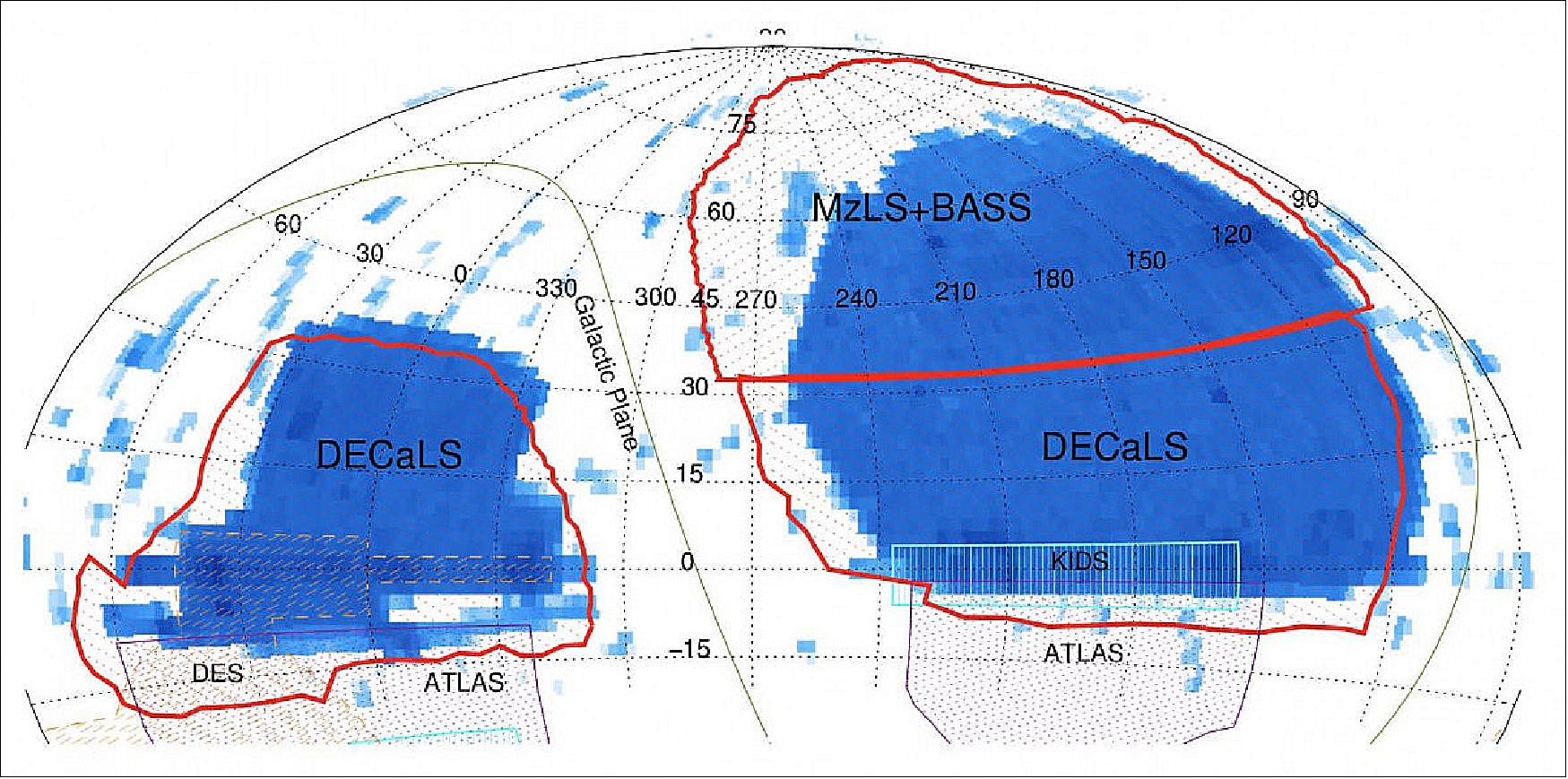
On-site survey crews – typically two DESI project researchers per observing night for each of the surveys – served in a sort of "lifeguard" role, Schlegel said. "When something went wrong they were there to fix it – to keep eyes on the sky," and researchers working remotely also aided in troubleshooting.
On the Final Night of the Final Survey ....
In early March, Eva-Maria Mueller, a postdoctoral researcher at the UK.'s University of Portsmouth, and Robert Blum, former deputy director at the National Optical Astronomy Observatory (NOAO) that manages the survey sites, were on duty with a small team in the control room of the NSF's Victor Blanco Telescope on a mile-high Chilean mountain for the final night of DECaLS survey imaging.
Seated several stories beneath the telescope, Mueller and Blum viewed images in real time to verify the telescope's position and focus. Mueller, who was participating in a five-night shift that was her first observing stint for the DESI surveys, said, "This was always kind of a childhood dream."
Blum, who had logged many evenings at the Blanco telescope for DECaLS, said, "It's really exciting to think about finishing this phase." He noted that this final night was focused on "cleaning up little holes" in the previous imaging. Blum is now serving in a new role as acting operations director for the Large Synoptic Survey Telescope under installation in Chile.
New software designed for the DESI surveys, and precise positioning equipment on the telescopes, has helped to automate the image-taking process, setting the exposure time and filters and compensating for atmospheric distortions and other factors that can affect the imaging quality, Blum noted. During a productive evening, it was common to produce about 150 to 200 images for the DECaLS survey.
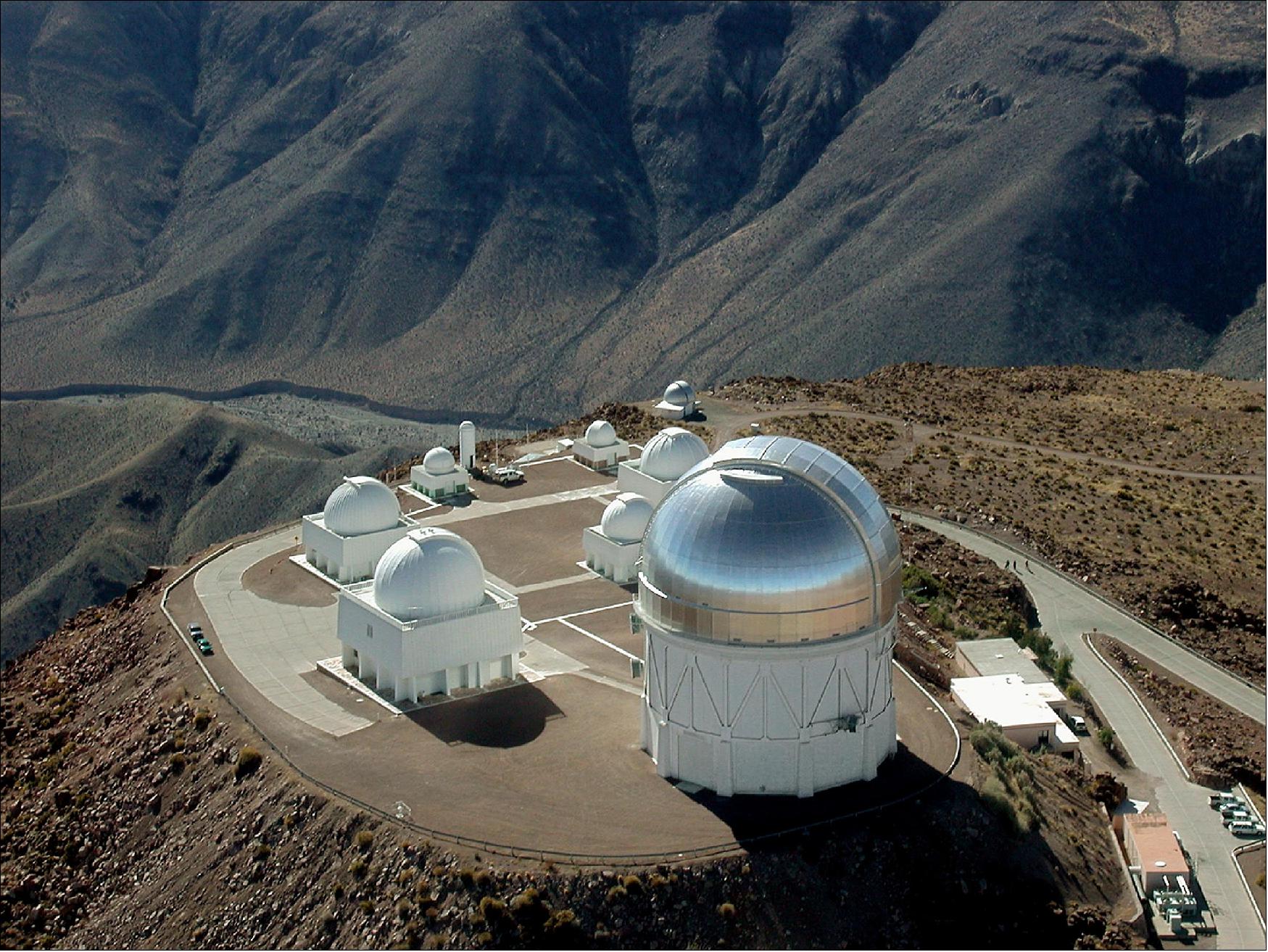
Cool Cosmic Cartography Experiment
The data from the surveys was routed to supercomputers at Berkeley Lab's NERSC (National Energy Research Scientific Computing Center), which will be the major storehouse for DESI data.
More than 100 researchers participated in night shifts to conduct the surveys, said Arjun Dey, the NOAO project scientist for DESI. Dey served as a lead scientist for the MzLS survey and a co-lead scientist on the DECaLS survey with Schlegel.
"We are building a detailed map of the universe and measuring its expansion history over the last 10 to 12 billion years," Dey said. "The DESI experiment represents the most detailed – and definitely the coolest – cosmic cartography experiment undertaken to date. Although the imaging was carried out for the DESI project, the data are publicly available so everyone can enjoy the sky and explore the cosmos."
BASS Survey Supported by Global Team
Xiaohui Fan, a University of Arizona astronomy professor who was a co-lead on the BASS survey conducted at Kitt Peak's Bok Telescope, coordinated viewing time by an international group that included co-leads Professor Zhou Xu and Associate Professor Zou Hu, other scientists from the NAOC (National Astronomical Observatories of China), and researchers from the University of Arizona and from across the DESI collaboration.
BASS produced about 100,000 images during its four-year run. It scanned a section of sky about 13 times larger than the Big Dipper, part of the Ursa Major constellation.
"This is a good example of how a collaboration is done," Fan said. "Through this international partnership we were bringing in people from around the world. This is a nice preview of what observing with DESI will be like."
Fan noted the DESI team's swift response in updating the telescope's hardware and software during the course of the survey. "It improved a lot in terms of automated controls and focusing and data reduction," he said. Most of the BASS survey imaging concluded in February, with some final images taken in March 2019.

Next Steps Toward DESI's Completion
All of the images gathered will be processed by a mathematical code, called Tractor, that helps to identify all of the galaxies surveyed and measure their brightness.
With the initial testing of the massive corrector barrel, which houses DESI's package of six large mirrors, in early April, the next major milestone for the project will be the delivery, installation, and testing of its focal plane, which caps the telescope and houses the robotic positioners.
The DESI Instrument
DESI is a Stage IV ground-based dark energy experiment that will study BAOs (Baryon Acoustic Oscillations) and the growth of structure through redshift-space distortions (RSD) with a wide-area galaxy and quasar redshift survey. DESI is the successor to the successful Stage-III BOSS (Baryon Oscillation Spectroscopic Survey) redshift survey and complements imaging surveys such as the Stage-III Dark Energy Survey (DES, operating 2013{2018) and the Stage-IV Large Synoptic Survey Telescope (LSST, planned start early in the next decade). DESI is an important component of the DOE Cosmic Frontier program, meeting the need for a wide-field spectroscopic survey identified in the 2011 "Rocky-III" dark energy community planning report. In addition to providing Stage IV constraints on dark energy, DESI will provide new measurements that can constrain theories of modified gravity and inflation, and that will measure the sum of neutrino masses. 4)
DESI, the first Stage IV dark energy experiment, will use the redshifts of 25 million galaxies to probe the nature of dark energy and test General Relativity. DESI builds on the successful Stage-III BOSS redshift survey, which has established BAO as a precision technique for dark energy exploration. DESI will make an order-of-magnitude advance over BOSS in volume observed and galaxy redshifts measured by using 5,000 robotically controlled fiber-positioners to feed a collection of spectrographs covering 360 nm to 980 nm. Newly designed optics for the National Optical Astronomy Observatory's 4-m Mayall telescope at Kitt Peak, Arizona, will provide a FOV (Field of View) of 8º x 8º. The telescope dome and telescope with the existing MOSAIC corrector are shown in Figure 4. 5)

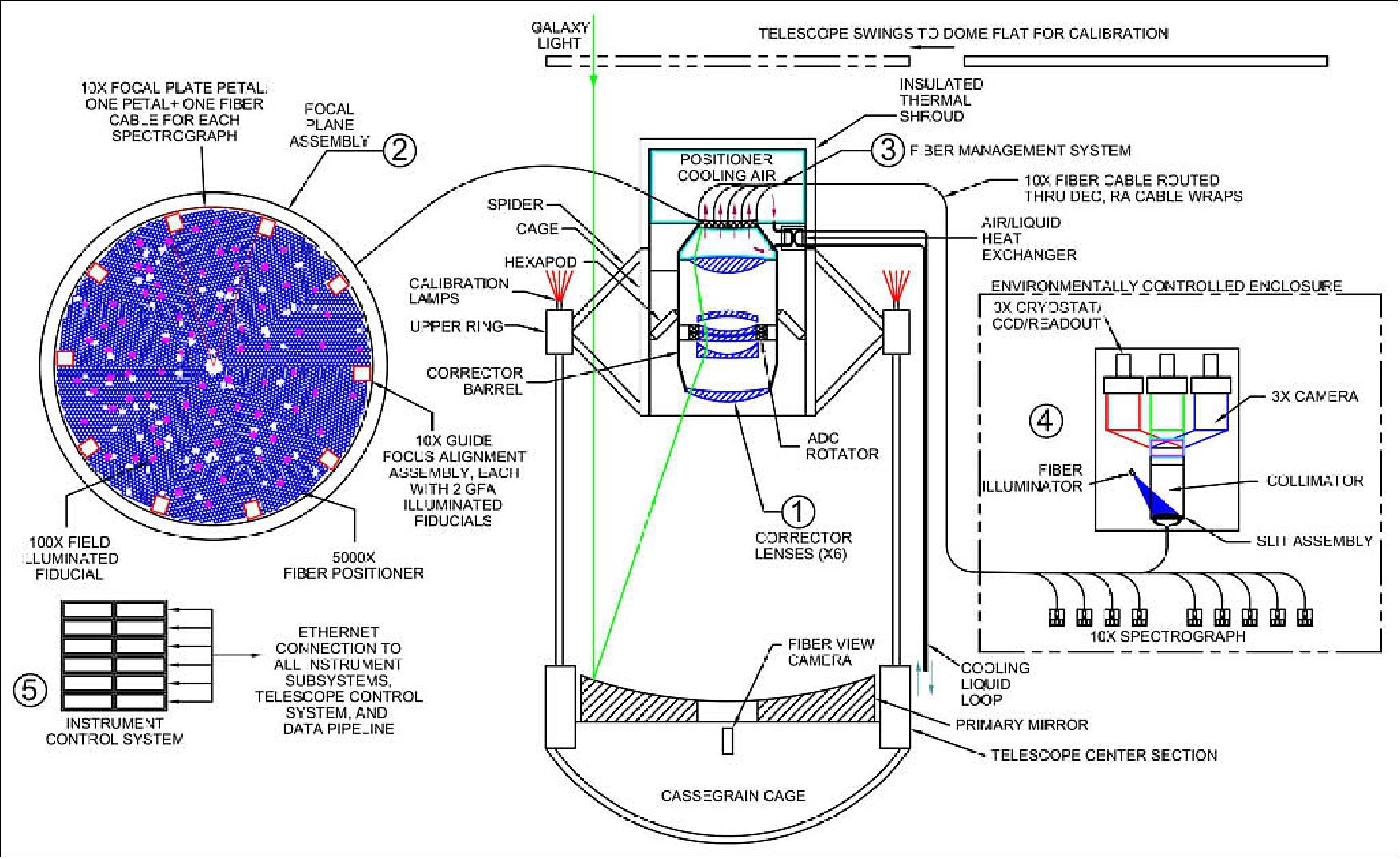
Over its 5-year observing lifetime, DESI will measure the spectra of more than 30 million galaxies and quasars covering 14,000 square degrees. The DESI instrument will provide unprecedented multi-object spectroscopy incorporating a novel design. 6)
DESI's new corrector optics provides a 3º diameter field of view that feeds a focal plate containing of 5,000 robotic positioners. The positioners can be reconfigured within 3 minutes to measure the spectra of a new set of galaxies. Optical fibers mounted to the positioners extend 50 meters down the telescope to feed 10 broadband spectrographs, each containing three detectors. The spectrographs cover a spectral range of 360 - 980 nm with a resolution of 2,000 to 5,000, enabling DESI to probe redshifts up to 1.7 for emission line galaxies and 3.5 for the lyman α spectra from quasars.
All commands and data transfers are run by the Instrument Control System, while the data acquisition system ensures accurate targeting and fast analysis of large amounts of data.
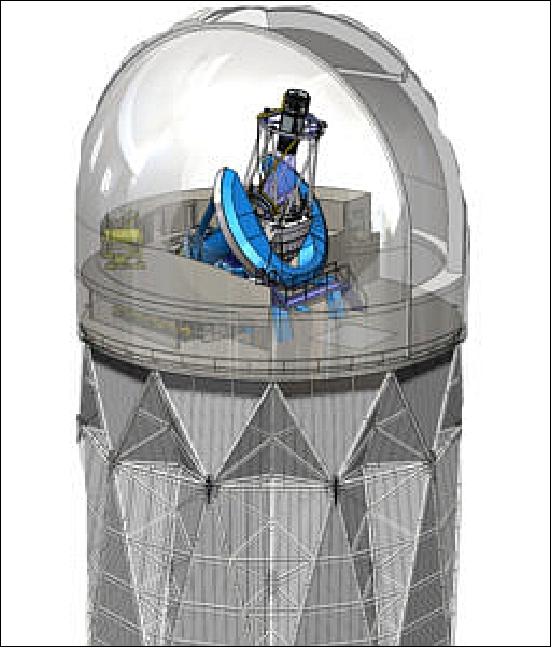
The instrument has been mounted on the 4-meter Mayall Telescope in 2018. The construction and integration of the instrument is the result of collaborations between several institutions.
The DESI project is sponsored by the US DOE (Department of Energy), the UK STFC (Science and Technology Facilities Council), the Heising-Simons Foundation, the Gordon and Betty Moore Foundation, AURA (Association of Universities for Research in Astronomy), the NSF (National Science Foundation) and NOAO (National Optical Astronomy Observatory).
DESI is the product of an international collaboration that brings together more than 450 researchers from more than 70 institutions including Australia, Canada, China, Colombia, France, Mexico, Spain, Switzerland, the U.K., and the U.S. The collaboration is led by Lawrence Berkeley National Laboratory, which is managed by the University of California for the U.S. Department of Energy's Office of Science. DESI is located at Kitt Peak National Observatory near Tucson, Arizona. Kitt Peak is part of the NSF's National Optical-Infrared Astronomy Research Laboratory (NSF's OIR Lab).
Development Status
• January 13, 2022: The Dark Energy Spectroscopic Instrument (DESI) has capped off the first seven months of its survey run by smashing through all previous records for three-dimensional galaxy surveys, creating the largest and most detailed map of the universe ever. Yet it's only about 10% of the way through its five-year mission. Once completed, that phenomenally detailed 3D map will yield a better understanding of dark energy, and thereby give physicists and astronomers a better understanding of the past – and future – of the universe. Meanwhile, the impressive technical performance and literally cosmic achievements of the survey thus far are helping scientists reveal the secrets of the most powerful sources of light in the universe. 7)
- DESI is an international science collaboration managed by the Department of Energy's Lawrence Berkeley National Laboratory (Berkeley Lab) with primary funding for construction and operations from DOE's Office of Science.
- DESI scientists are presenting the performance of the instrument, and some early astrophysics results, this week at a Berkeley Lab-hosted webinar called CosmoPalooza, which will also feature updates from other leading cosmology experiments.

- "There is a lot of beauty to it," said Berkeley Lab scientist Julien Guy, one of the speakers. "In the distribution of the galaxies in the 3D map, there are huge clusters, filaments, and voids. They're the biggest structures in the universe. But within them, you find an imprint of the very early universe, and the history of its expansion since then."
- DESI has come a long way to reach this point. Originally proposed over a decade ago, construction on the instrument started in 2015. It was installed at the Nicholas U. Mayall 4-meter telescope at Kitt Peak National Observatory near Tucson, Arizona. Kitt Peak National Observatory is a program of the National Science Foundation's (NSF) NOIRLab, which the Department of Energy contracts with to operate the Mayall Telescope for the DESI survey. The instrument saw first light in late 2019. Then, during its validation phase, the coronavirus pandemic hit, shutting down the telescope for several months, though some work continued remotely. In December 2020, DESI turned its eyes to the sky again, testing out its hardware and software, and by May 2021 it was ready to start its science survey.
- But work on DESI itself didn't end once the survey started. "It's constant work that goes on to make this instrument perform," said physicist Klaus Honscheid of Ohio State University, co-Instrument Scientist on the project, who will deliver the first paper of the CosmoPalooza DESI session. Honscheid and his team ensure the instrument runs smoothly and automatically, ideally without any input during a night's observing. "The feedback I get from the night observers is that the shifts are boring, which I take as a compliment," he said.
- But that monotonous productivity requires incredibly detailed control over each of the 5000 cutting-edge robots that position optical fibers on the DESI instrument, ensuring their positions are accurate to within 10 microns. "Ten microns is tiny," said Honscheid. "It's less than the thickness of a human hair. And you have to position each robot to collect the light from galaxies billions of light-years away. Every time I think about this system, I wonder how could we possibly pull that off? The success of DESI as an instrument is something to be very proud of."
Seeing Dark Energy's True Colors
- That level of accuracy is needed to accomplish the primary task of the survey: collecting detailed color spectrum images of millions of galaxies across more than a third of the entire sky. By breaking down the light from each galaxy into its spectrum of colors, DESI can determine how much the light has been redshifted – stretched out toward the red end of the spectrum by the expansion of the universe during the billions of years it traveled before reaching Earth. It is those redshifts that let DESI see the depth of the sky.
- The more redshifted a galaxy's spectrum is, in general, the farther away it is. With a 3D map of the cosmos in hand, physicists can chart clusters and superclusters of galaxies. Those structures carry echoes of their initial formation, when they were just ripples in the infant cosmos. By teasing out those echoes, physicists can use DESI's data to determine the expansion history of the universe.
- "Our science goal is to measure the imprint of waves in the primordial plasma," said Guy. "It's astounding that we can actually detect the effect of these waves billions of years later, and so soon in our survey."
- Understanding the expansion history is crucial, with nothing less than the fate of the entire universe at stake. Today, about 70% of the content of the universe is dark energy, a mysterious form of energy driving the expansion of the universe ever faster. As the universe expands, more dark energy pops into existence, which speeds up the expansion more, in a cycle that is driving the fraction of dark energy in the universe ever upwards. Dark energy will ultimately determine the destiny of the universe: will it expand forever? Will it collapse onto itself again, in a Big Bang in reverse? Or will it rip itself apart? Answering these questions means learning more about how dark energy has behaved in the past – and that's exactly what DESI is designed to do. And by comparing the expansion history with the growth history, cosmologists can check whether Einstein's theory of general relativity holds over these immense spans of space and time.
Black Holes and Bright Galaxies
- But understanding the fate of the universe will have to wait until DESI has completed more of its survey. In the meantime, DESI is already driving breakthroughs in our understanding of the distant past, more than 10 billion years ago when galaxies were still young.
- "It's pretty amazing," said Ragadeepika Pucha, a graduate student in astronomy at the University of Arizona working on DESI. "DESI will tell us more about the physics of galaxy formation and evolution."
- Pucha and her colleagues are using DESI data to understand the behavior of intermediate-mass black holes in small galaxies. Enormous black holes are thought to inhabit the cores of nearly every large galaxy, like our own Milky Way. But whether small galaxies always contain their own (smaller) black holes at their cores is still not known. Black holes on their own can be nearly impossible to find – but if they attract enough material, they become easier to spot. When gas, dust, and other material falling into the black hole heats up (to temperatures hotter than the core of a star) on its way in, an active galactic nucleus (AGN) is formed. In large galaxies, AGNs are among the brightest objects in the known universe. But in smaller galaxies, AGNs can be much fainter, and harder to distinguish from newborn stars. The spectra taken by DESI can help solve this problem – and its wide reach across the sky will yield more information about the cores of small galaxies than ever before. Those cores, in turn, will give scientists clues about how bright AGNs formed in the very early universe.
- Quasars – a particularly bright variety of galaxies – are among the brightest and most distant objects known. "I like to think of them as lampposts, looking back in time into the history of the universe," said Victoria Fawcett, an astronomy graduate student at Durham University in the UK. Quasars are excellent probes of the early universe because of their sheer power; DESI's data will go back in time 11 billion years.
- Fawcett and her colleagues are using DESI data to understand the evolution of quasars themselves. It is thought that quasars start out surrounded by an envelope of dust, which reddens the light they give off, like the sun through haze. As they age, they drive off this dust and become bluer. But it has been hard to test this theory, because of the paucity of data on red quasars. DESI is changing that, finding more quasars than any prior survey, with an estimated 2.4 million quasars expected in the final survey data.
- "DESI is really great because it's picking up much fainter and much redder objects," said Fawcett. That, she adds, allows scientists to test ideas about quasar evolution that just couldn't be tested before. And this isn't just limited to quasars. "We're finding quite a lot of exotic systems, including large samples of rare objects that we just haven't been able to study in detail before," Fawcett said.
- There's more to come for DESI. The survey has already cataloged over 7.5 million galaxies and is adding more at a rate of over a million a month. In November 2021 alone, DESI cataloged redshifts from 2.5 million galaxies. By the end of its run in 2026, DESI is expected to have over 35 million galaxies in its catalog, enabling an enormous variety of cosmology and astrophysics research.
- "All this data is just there, and it's just waiting to be analyzed," said Pucha. "And then we will find so much amazing stuff about galaxies. For me, that's exciting."
- DESI is supported by the DOE Office of Science and by the National Energy Research Scientific Computing Center, a DOE Office of Science user facility. Additional support for DESI is provided by the U.S. National Science Foundation, the Science and Technologies Facilities Council of the United Kingdom, the Gordon and Betty Moore Foundation, the Heising-Simons Foundation, the French Alternative Energies and Atomic Energy Commission (CEA), the National Council of Science and Technology of Mexico, the Ministry of Economy of Spain, and by the DESI member institutions.
- The DESI collaboration is honored to be permitted to conduct scientific research on Iolkam Du'ag (Kitt Peak), a mountain with particular significance to the Tohono O'odham Nation.
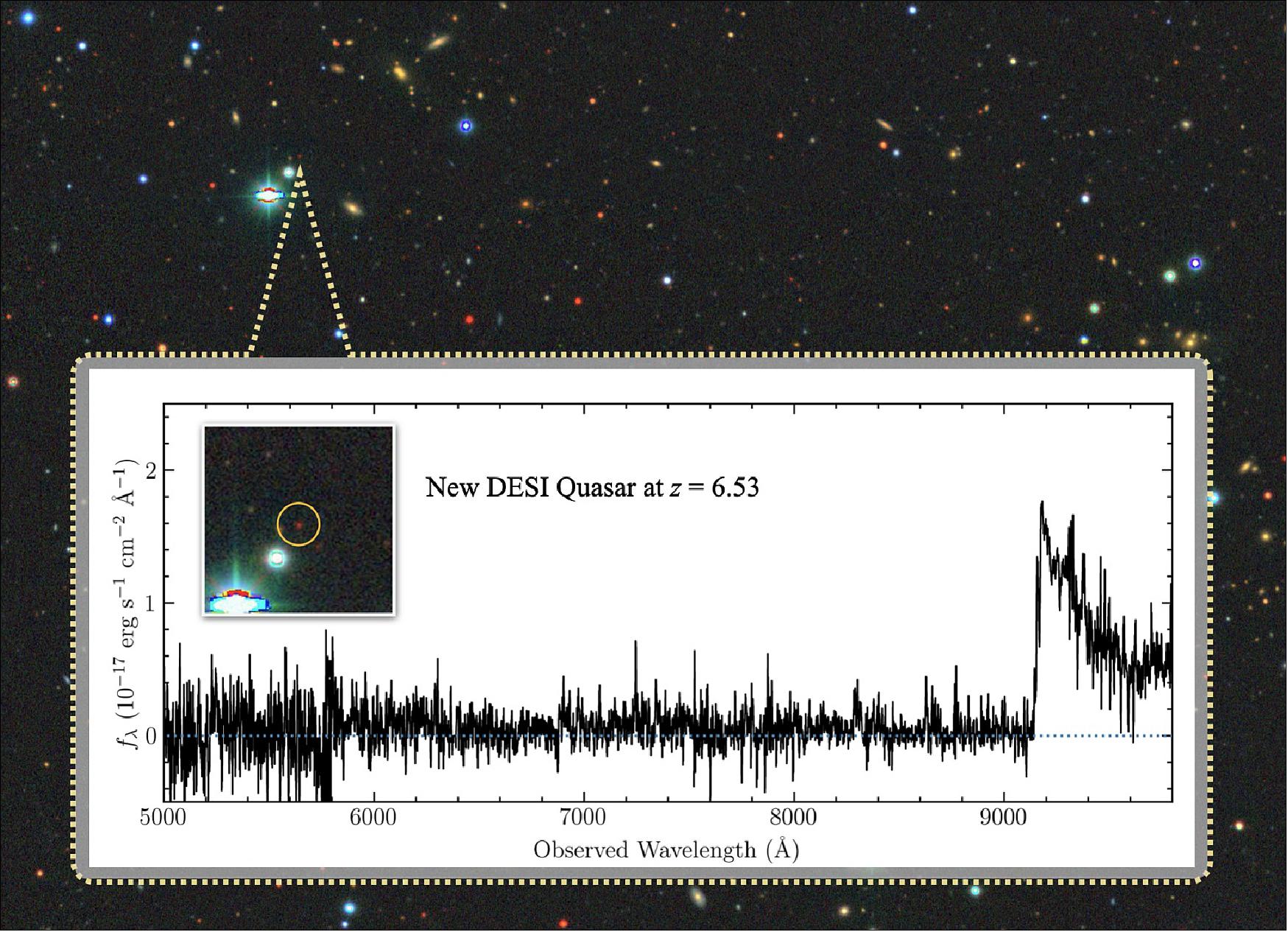
• May 17, 2021: A five-year quest to map the universe and unravel the mysteries of "dark energy" is beginning officially today, May 17, at Kitt Peak National Observatory near Tucson, Arizona. To complete its quest, the Dark Energy Spectroscopic Instrument (DESI) will capture and study the light from tens of millions of galaxies and other distant objects in the universe. 8)
- DESI is an international science collaboration managed by the Department of Energy's Lawrence Berkeley National Laboratory (Berkeley Lab) with primary funding for construction and operations from DOE's Office of Science.
- By gathering light from some 30 million galaxies, project scientists say DESI will help them construct a 3D map of the universe with unprecedented detail. The data will help them better understand the repulsive force associated with "dark energy" that drives the acceleration of the expansion of the universe across vast cosmic distances.
- Jim Siegrist, Associate Director for High Energy Physics at DOE, said "We are excited to see the start of DESI, the first next-generation dark energy project to begin its science survey. We also congratulate Berkeley Lab, which continues to enhance our capabilities for studying the nature of dark energy, since leading the initial discovery in 1999. DOE's Berkeley Lab successfully led the 13-nation DESI team, including U.S. government, private and international contributions, in the design, fabrication, and commissioning of the world's premier multi-object spectrograph. The strong interagency collaboration with NSF has enabled DOE to install and operate DESI on their Mayall telescope, which is required to carry out this amazing experiment. Along with its primary mission of dark energy studies, the data set will be of use by the wider scientific community for a multitude of astrophysics studies."
- What sets DESI apart from previous sky surveys? The project director, Berkeley Lab's Michael Levi, said, "We will measure 10 times more galaxy spectra than ever obtained. These spectra get us a third dimension." Instead of two-dimensional images of galaxies, quasars, and other distant objects, he explained, the instrument collects light, or spectra, from the cosmos such that it "becomes a time machine where we place those objects on a timeline that reaches as far back as 11 billion years ago."
- "DESI is the most ambitious of a new generation of instruments aimed at better understanding the cosmos – in particular, its dark energy component," said project co-spokesperson Nathalie Palanque-Delabrouille, a cosmologist at France's Alternative Energies and Atomic Energy Commission (CEA). She said the scientific program – including her own interest in quasars – will allow researchers to address with precision two primary questions: what is dark energy; and the degree to which gravity follows the laws of general relativity, which form the basis of our understanding of the cosmos.
- "It's been a long journey from the first steps that we took almost a decade ago to design the survey, then to decide which targets to observe, and now to have the instruments so that we can achieve those science goals," Palanque-Delabrouille, said. "It's very exciting to see where we stand today."
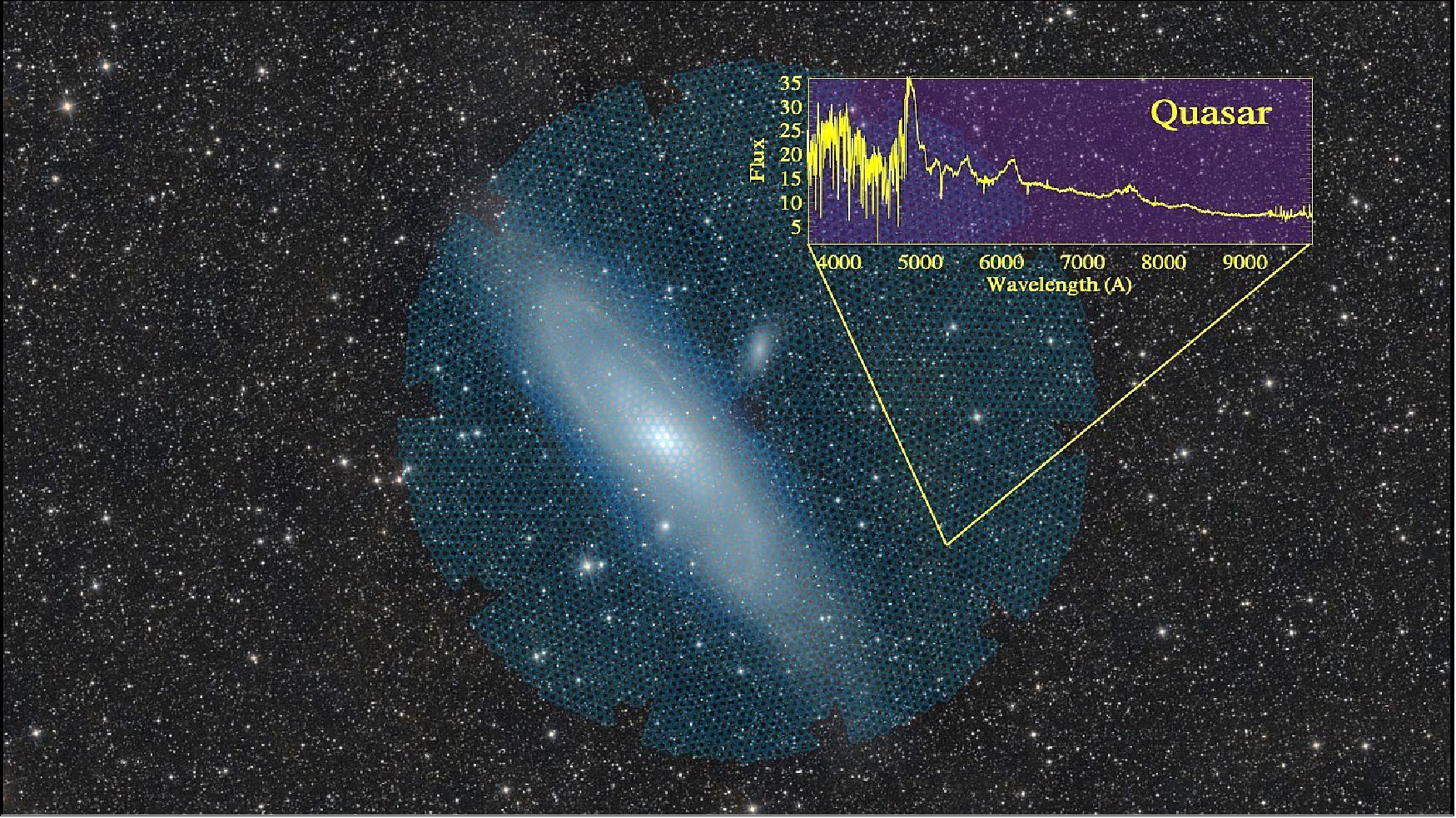
- The formal start of DESI's five-year survey follows a four-month trial run of its custom instrumentation that captured four million spectra of galaxies – more than the combined output of all previous spectroscopic surveys.
- The DESI instrument was installed on the Nicholas U. Mayall 4-meter Telescope at Kitt Peak National Observatory. Kitt Peak National Observatory is a program of the National Science Foundation's (NSF) NOIRLab, which has allowed the Department of Energy to operate the Mayall Telescope for the DESI survey. The instrument includes new optics that increase the field of view of the telescope and includes 5,000 robotically controlled optical fibers to gather spectroscopic data from an equal number of objects in the telescope's field of view.
- "We're not using the biggest telescopes," said Berkeley Lab's David Schlegel, who is DESI project scientist. "It's that the instruments are better and very highly multiplexed, meaning that we can capture the light from many different objects at once."
- In fact, the telescope "is literally pointing at 5,000 different galaxies simultaneously," Schlegel said. On any given night, he explains, as the telescope is moved into a target position, the optical fibers align to collect light from galaxies as it is reflected off the telescope mirror. From there, the light is fed into a bank of spectrographs and CCD cameras for further processing and study.
- "It's really a factory that we have – a spectra factory," said survey validation lead, Christophe Yeche, also a cosmologist at CEA. "We can collect 5,000 spectra every 20 minutes. In a good night, we collect spectra from some 150,000 objects."
- "But it's not just the instrument hardware that got us to this point – it's also the instrument software, DESI's central nervous system," said Klaus Honscheid, a professor of physics at Ohio State University who directed the design of the DESI instrument control and monitoring systems. He credits scores of people in his group and around the world who have built and tested thousands of DESI's component parts, most of which are unique to the instrument.
- Spectra collected by DESI are the components of light corresponding to the colors of the rainbow. Their characteristics, including wavelength, reveal information such as the chemical composition of objects being observed as well as information about their relative distance and velocity.
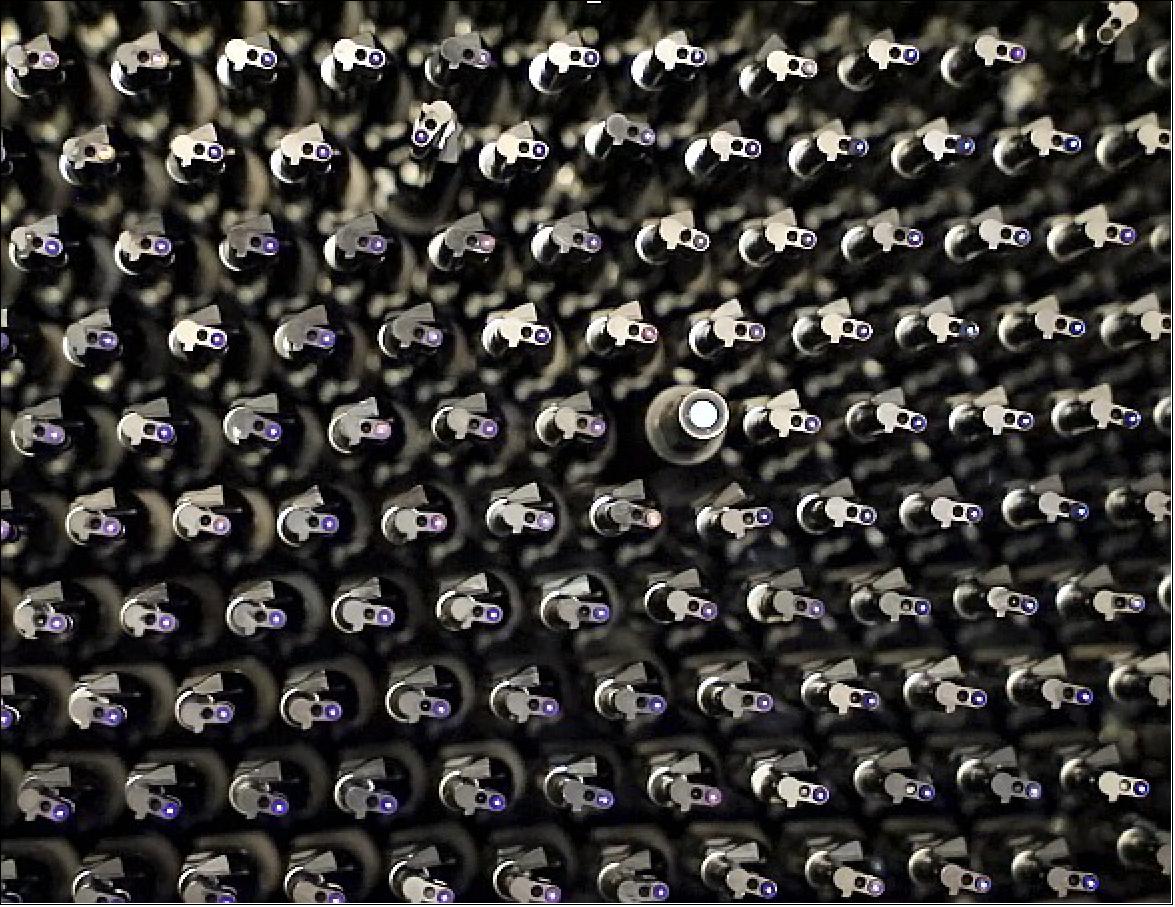
- As the universe expands, galaxies move away from each other, and their light is shifted to longer, redder wavelengths. The more distant the galaxy, the greater its "redshift." By measuring galaxy redshifts, DESI researchers will create a 3D map of the universe. The detailed distribution of galaxies in the map is expected to yield new insights on the influence and nature of dark energy.
- "Dark energy is one of the key science drivers for DESI," said project co-spokesperson Kyle Dawson, a professor of physics and astronomy at University of Utah. "The goal is not so much to find out how much there is – we know that about 70% of the energy in the universe today is dark energy – but to study its properties."
- The universe is expanding at a rate determined by its total energy contents, Dawson explains. As the DESI instrument looks out in space and time, he says, "we can literally take snapshots today, yesterday, 1 billion years ago, 2 billion years ago – as far back in time as possible. We can then figure out the energy content in these snapshots and see how it is evolving."
- DESI is supported by the DOE Office of Science and by the National Energy Research Scientific Computing Center, a DOE Office of Science user facility. Additional support for DESI is provided by the U.S. National Science Foundation, the Science and Technologies Facilities Council of the United Kingdom, the Gordon and Betty Moore Foundation, the Heising-Simons Foundation, the French Alternative Energies and Atomic Energy Commission (CEA), the National Council of Science and Technology of Mexico, the Ministry of Economy of Spain, and by the DESI member institutions.
- The DESI collaboration is honored to be permitted to conduct scientific research on Iolkam Du'ag (Kitt Peak), a mountain with particular significance to the Tohono O'odham Nation.
• December 13, 2020: The recently commissioned Dark Energy Spectroscopic Instrument (DESI) will measure the expansion history of the universe using the Baryon Acoustic Oscillation technique. The spectra of 35 million galaxies and quasars over 14000 sq deg will be measured during the life of the experiment. A new prime focus corrector for the KPNO (Kitt Peak National Observatory) Mayall telescope delivers light to 5000 fiber optic positioners. The fibers in turn feed ten broad-band spectrographs. We describe key aspects and lessons learned from the development, delivery and installation of the fiber system at the Mayall telescope. 9)
• June 1, 2020: Even as the DESI (Dark Energy Spectroscopic Instrument) lies dormant within a telescope dome on a mountaintop in Arizona, due to the COVID-19 pandemic, the DESI project has moved forward in reaching the final formal approval milestone prior to startup. 10)
- DESI is designed to gather the light of tens of millions of galaxies, and several million ultrabright deep-sky objects called quasars, using fiber-optic cables that are automatically positioned to point at 5,000 galaxies at a time by an orchestrated set of swiveling robots. The gathered light is measured by a group of 10 devices called spectrographs, which split the light into its spectrum, or separate colors.
- The measurements will help scientists map the universe in 3D and learn more about mysterious dark energy – which drives the universe's accelerating expansion – and could also provide new insight about the life cycle of galaxies and about the cosmic web that connects matter in the universe.
Project Completion cCulminates 10-year Effort by International Team
- After DESI passed a federal review in March, members of a federal advisory board formally approved the completion of the project on Monday, May 11. DESI was designed and built through the efforts of a large international collaboration that now numbers about 500 researchers at 75 institutions in 13 nations.
- "Congratulations to the DESI team of U.S. and international labs and universities in developing this amazing, state-of-the-art spectroscopic instrument," said Kathleen Turner, DESI program manager at the Department of Energy's Office of High Energy Physics. "We are all looking forward to using DESI's exquisite precision to map the expansion of the universe over time."
- Michael Levi, DESI project director and a scientist at the Department of Energy's Lawrence Berkeley National Laboratory (Berkeley Lab), which is the lead institution in the project, said, "This is the culmination of 10 years of hard work by an incredibly dedicated and talented team, and a major accomplish for all involved."
- He added, "We understand and appreciate the extraordinary privilege we have been given to work with this instrument – and even more so during this challenging time, as we continue as scientists to explore what lies beyond our world."
Preparing for a Restart in DESI Testing
- In mid-March it became clear that a final testing phase of the instrument would be abruptly suspended due to the temporary shutdown of most activities at Kitt Peak National Observatory (KPNO), where DESI is located, to reduce the risk of spreading COVID-19.
- Project participants moved quickly to capture a large, last batch of sky data during the March 14-15 weekend before the instrument was temporarily shuttered the following week, and that data proved useful in the project's review for the construction completion milestone, known as CD-4 (Critical Decision 4).
- In the months leading up to the temporary reduction in operations at KPNO, which is a Program of the National Science Foundation's NOIRLab, researchers had engaged in DESI observing runs to troubleshoot technical snags and ensure its components are functioning properly.
- Now, project participants say they are looking forward to a return to DESI testing in preparation for its startup and five-year mission.
- "The early returns from the instrument were very gratifying after years of development," said Daniel Eisenstein, a DESI spokesperson and Harvard University astronomy professor. "Now the whole team is eager to learn what DESI data will teach us about the Universe."
• October 28, 2019: A new instrument mounted atop a telescope in Arizona has aimed its robotic array of 5,000 fiber-optic "eyes" at the night sky to capture the first images showing its unique view of galaxy light. 11)
- It was the first test of the Dark Energy Spectroscopic Instrument, known as DESI, with its nearly complete complement of components. The long-awaited instrument is designed to explore the mystery of dark energy, which makes up about 68 percent of the universe and is speeding up its expansion.
- DESI's components are designed to automatically point at preselected sets of galaxies, gather their light, and then split that light into narrow bands of color to precisely map their distance from Earth and gauge how much the universe expanded as this light traveled to Earth. In ideal conditions DESI can cycle through a new set of 5,000 galaxies every 20 minutes.
- The latest milestone, achieved Oct. 22, marks the opening of DESI's final testing toward the formal start of observations in early 2020.
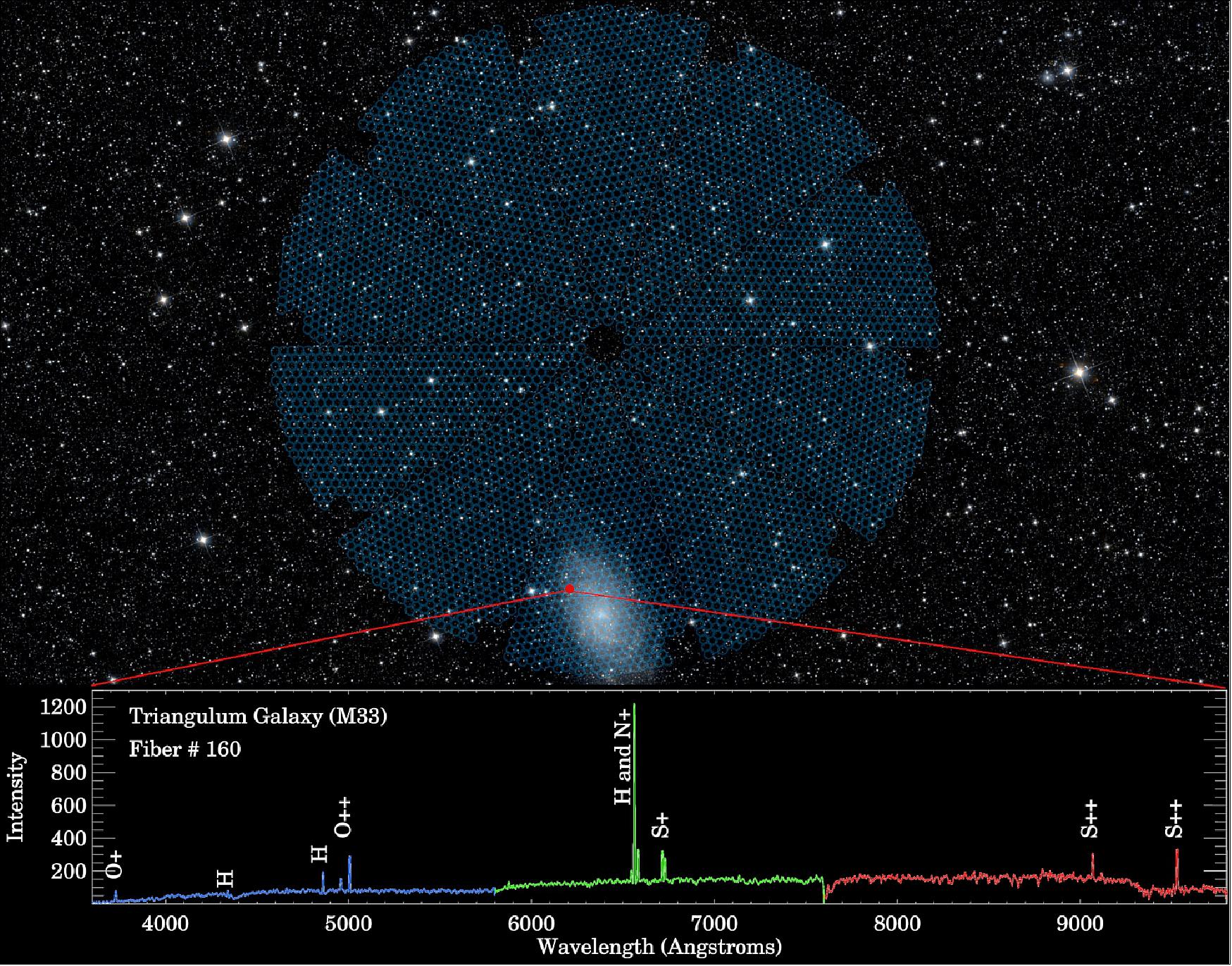
- Like a powerful time machine, DESI will peer deeply into the universe's infancy and early development – up to about 11 billion years ago – to create the most detailed 3D map of the universe.
- By repeatedly mapping the distance to 35 million galaxies and 2.4 million quasars across one-third of the area of the sky over its five-year run, DESI will teach us more about dark energy. Quasars, among the brightest objects in the universe, allow DESI to look deeply into the universe's past.
- DESI will provide very precise measurements of the universe's expansion rate. Gravity had slowed this rate of expansion in the early universe, though dark energy has since been responsible for speeding up its expansion.
- "After a decade in planning and R&D, installation and assembly, we are delighted that DESI can soon begin its quest to unravel the mystery of dark energy," said DESI Director Michael Levi of the Department of Energy's Lawrence Berkeley National Laboratory (Berkeley Lab), the lead institution for DESI's construction and operations.
- "Most of the universe's matter and energy are dark and unknown, and next-generation experiments like DESI are our best bet for unraveling these mysteries," Levi added. "I am thrilled to see this new experiment come to life."
- Installation of DESI began in February 2018 at the Nicholas U. Mayall Telescope at Kitt Peak National Observatory near Tucson, Arizona.
- "With DESI we are combining a modern instrument with a venerable old telescope to make a state-of-the-art survey machine." said Lori Allen, director of Kitt Peak National Observatory at the National Science Foundation's National Optical-Infrared Astronomy Research Laboratory.
- Over the past 18 months, a bevy of DESI components were shipped to the site from institutions around the globe and installed on the telescope.
- Among the early arrivals was an assembly of lenses packaged in a large steel barrel, together weighing in at three tons. This corrector barrel sits over the 4-meter primary mirror of the Mayall Telescope and provides an expansive field of view. The lenses, each measuring about a meter across, were successfully tested in April.
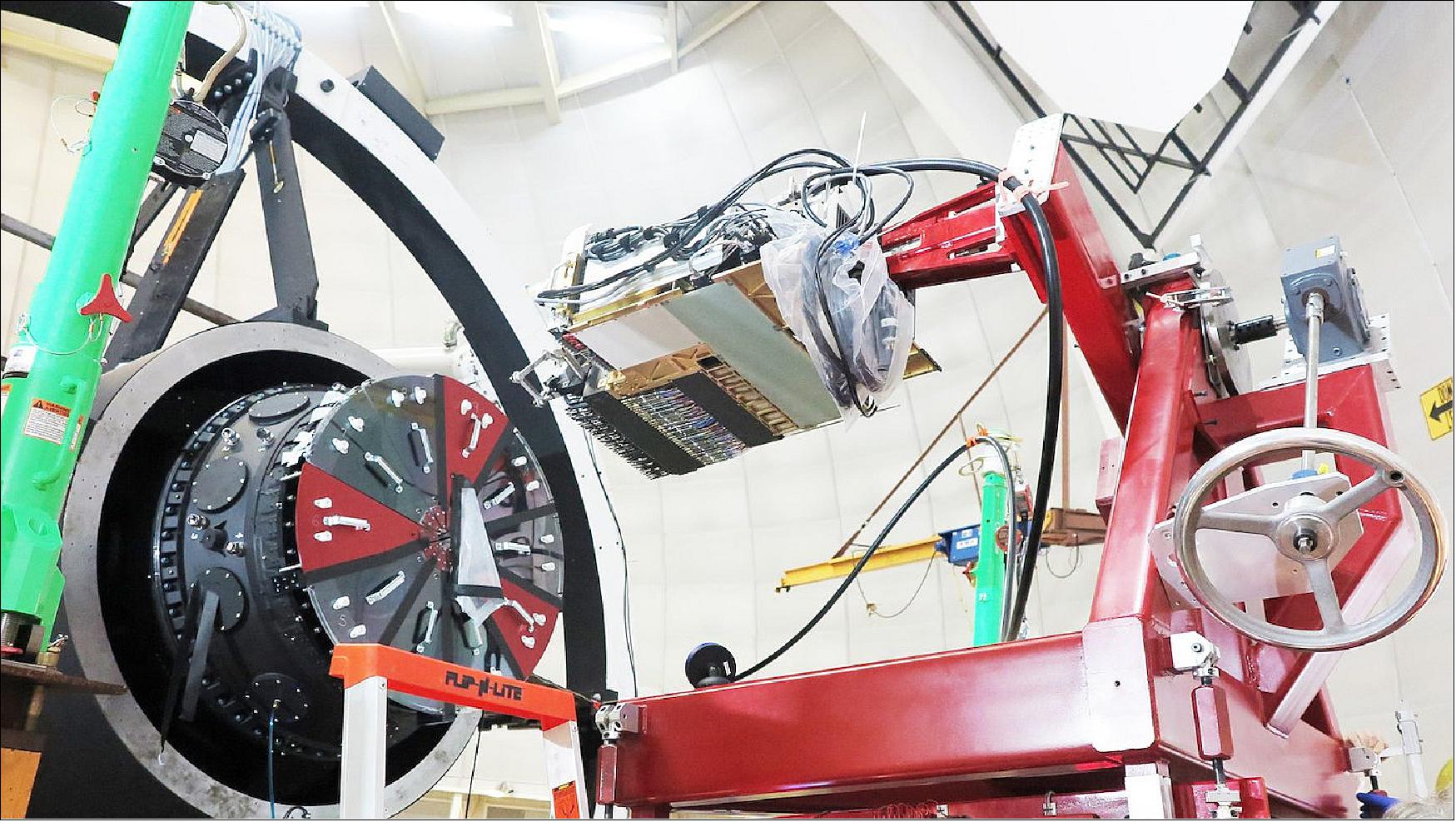
- DESI's focal plane, which carries 5,000 robotic positioners that swivel in a choreographed "dance" to individually focus on galaxies, is at the top of the telescope.
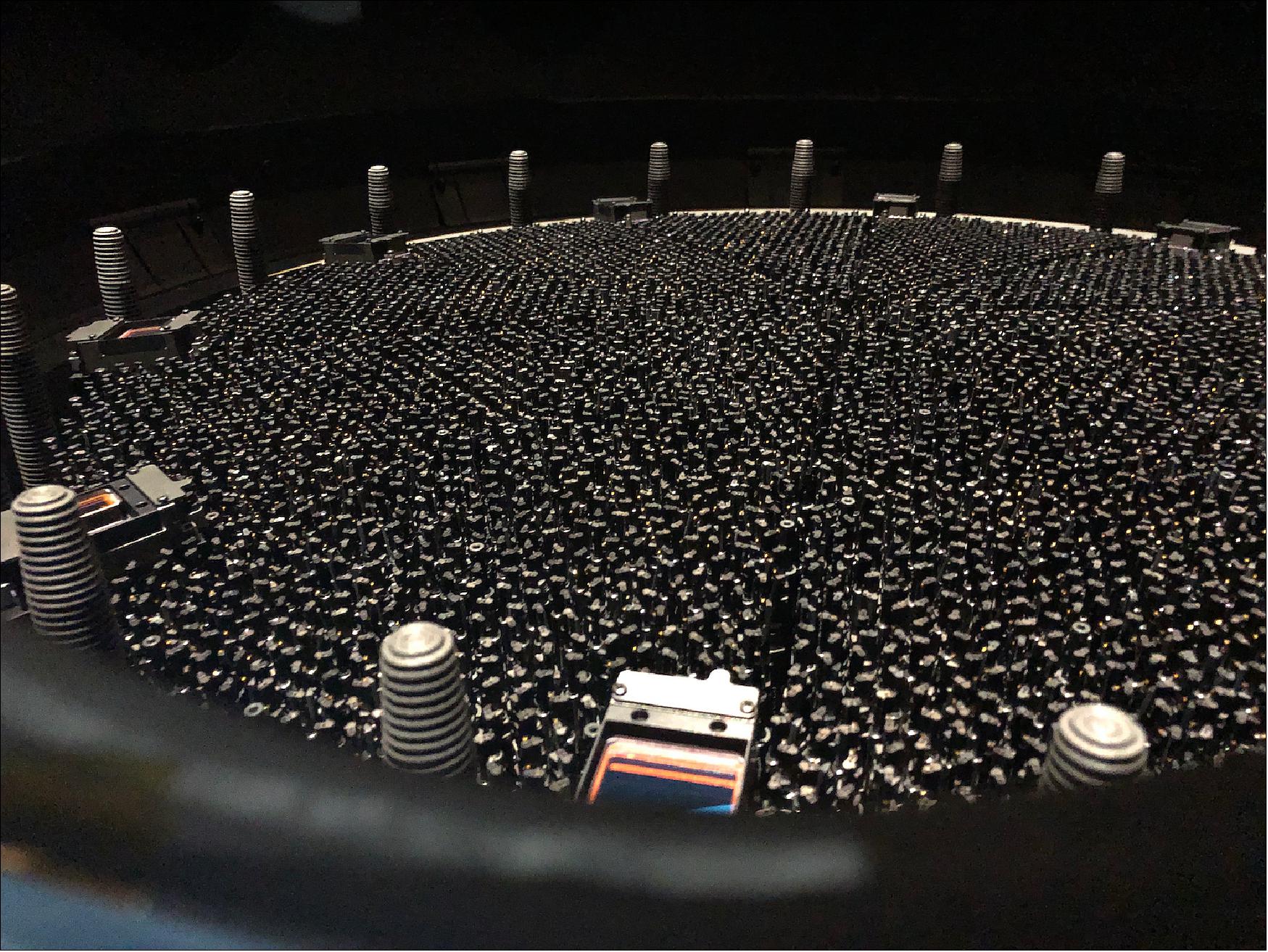
- These little robots – which each hold a light-gathering fiber-optic cable that is about the average width of a human hair – serve as DESI's eyes. It takes about 10 seconds for the positioners to swivel to a new sequence of targeted galaxies. With its unprecedented surveying speed, DESI will map over 20 times more objects than any predecessor experiment.
- The focal plane, which is comprised of a half-million individual parts, is arranged in a series of 10 wedge-shaped petals that each contain 500 positioners and a little camera to help the telescope point and focus.
- The focal plane, corrector barrel, and other DESI components weigh 11 tons, and the Mayall telescope's movable arm that DESI is installed on, has a mass of 250 tons and rises ~27 m above the floor in the Mayall's 14-story dome (Figure 6).
- Among the more recent arrivals at Kitt Peak is the collection of spectrographs that are designed to split up the gathered light into three separate color bands to allow precise distance measurements of the observed galaxies across a broad range of colors.
- Among the more recent arrivals at Kitt Peak is the collection of spectrographs that are designed to split up the gathered light into three separate color bands to allow precise distance measurements of the observed galaxies across a broad range of colors.
- These spectrographs, which allow DESI's robotic eyes to "see" even faint, distant galaxies, are designed to measure redshift, which is a shift in the color of objects to longer, redder wavelengths due to the objects' movement away from us. Redshift is analogous to how the sound of a fire engine's siren shifts to lower tones as it moves away from us.
- There are now eight spectrographs installed, with the final two arriving before year-end. To connect the focal plane with the spectrographs, which are located beneath the telescope, DESI is equipped with about 150 miles of fiber-optic cabling.
- "This is a very exciting moment," said Nathalie Palanque-Delabrouille, a DESI spokesperson and an astrophysics researcher at France's Atomic Energy Commission (CEA) who has participated in the selection process to determine which galaxies and other objects DESI will observe.
- "The instrument is all there. It has been very exciting to be a part of this from the start," she said. "This is a very significant advance compared to previous experiments. By looking at objects very far away from us, we can actually map the history of the universe and see what the universe is composed of by looking at very different objects from different eras."
- Palanque-Delabrouille's institution, CEA, contributed a specialized cooling system to optimize the performance of the light sensors (known as CCDs or charge-coupled devices) that enable DESI's broad color-sampling range.
- Gregory Tarlé, a physics professor at the University of Michigan (UM) who led the student teams that assembled the robotic positioners for DESI and related components, said it's gratifying to reach a stage in the project where all of DESI's complex components are functioning together.
- UM delivered a total of 7,300 robotic positioners, including spares. During the production peak, the teams were churning out about 50 positioners a day.
- "It was quite a process," Tarlé said. "We were at the limits of precision for these production parts."
- The positioners were installed in the focal plane petals at Berkeley Lab, and after assembly and testing the completed petals were shipped to Kitt Peak and installed one at a time on the Mayall Telescope.
- Now that the hard work of building DESI is largely done, Tarlé said he looks forward to DESI discoveries.
- "I want to find out what the nature of dark energy is," he said. "We finally have a shot at really trying to understand the nature of this stuff that dominates the universe."
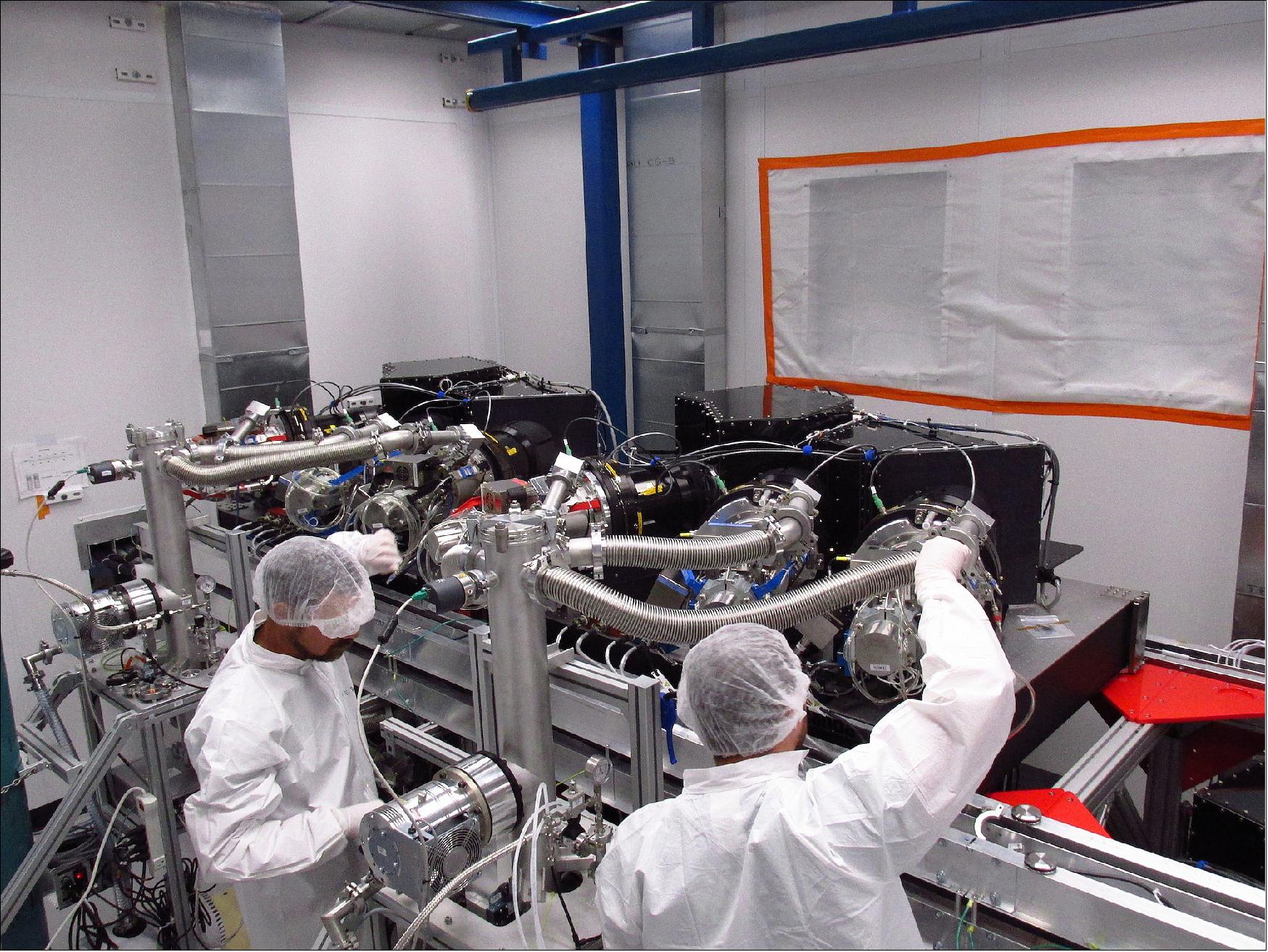
• April 12, 2019: DESI, the Dark Energy Spectroscopic Instrument, will mobilize 5,000 swiveling robots – each one pointing a thin strand of fiber-optic cable – to gather the light from about 35 million galaxies. 12)
- The little robots are designed to fix on a series of preselected sky objects that are as distant as 12 billion light-years away. By studying how these galaxies are drifting away from us, DESI will provide precise measurements of the accelerating rate at which the universe is expanding.
- This expansion rate is caused by an invisible force known as dark energy, which is one of the biggest mysteries in astrophysics and accounts for an estimated 68 percent of all mass and energy in the universe.
- In this video, DESI project participants share their insight and excitement about the project and its potential for new and unexpected discoveries.
References
1) "Dark Energy Spectroscopic Instrument," LBL (Lawrence Berkeley Lab), URL: https://www.desi.lbl.gov/science/
2) "Dark Energy Spectroscopic Instrument, the DESI survey," URL: https://www.desi.lbl.gov/the-desi-survey/
3) Glenn Roberts Jr. "3 Sky Surveys Completed in Preparation for Dark Energy Spectroscopic Instrument, Researchers will pick 35 million galaxies and quasars to target during DESI's 5-year mission," LBL (Lawrence Berkeley Lab), 8 July 2019, URL: https://newscenter.lbl.gov/2019/07/08/3-sky-surveys-completed-in-preparation-for-dark-energy-spectroscopic-instrument/
4) DESI Collaboration: Amir Aghamousa, Jessica Aguilar, Steve Ahlen, Shadab Alam,Lori E. Allen, Carlos Allende Prieto, James Annis, Stephen Bailey, Christophe Balland,Otger Ballester, Charles Baltay, Lucas Beaufore, Chris Bebek, Timothy C. Beers, EricF. Bell, Jos Luis Berna, Robert Besuner, Florian Beutler, Chris Blake, HannesBleuler, Michael Blomqvist, Robert Blum, Adam S. Bolton, Cesar Briceno, DavidBrooks, Joel R. Brownstein, Elizabeth Buckley-Geer, Angela Burden, Etienne Burtin,Nicolas G. Busca, Robert N. Cahn, Yan-Chuan Cai, Laia Cardiel-Sas, Raymond G.Carlberg, Pierre-Henri Carton, Ricard Casas, Francisco J. Castander, Jorge L.Cervantes-Cota, Todd M. Claybaugh, Madeline Close, Carl T. Coker, Shaun Cole, JohanComparat, Andrew P. Cooper, M.-C. Cousinou, Martin Crocce, Jean-Gabriel Cuby,Daniel P. Cunningham, Tamara M. Davis, Kyle S. Dawson, Axel de la Macorra, Juan DeVicente, Timothée Delubac, Mark Derwent, Arjun Dey, Govinda Dhungana, ZhejieDing, Peter Doel, Yutong T. Duan, Anne Ealet, Jerry Edelstein, Sarah Eftekharzadeh, et al., "The DESI Experiment Part I: Science,Targeting, and Survey Design," Instrumentation and Methods for Astrophysics, October 2016, URL: https://arxiv.org/pdf/1611.00036.pdf
5) DESI Collaboration: Amir Aghamousa, Jessica Aguilar, Steve Ahlen, Shadab Alam,Lori E. Allen, Carlos Allende Prieto, James Annis, Stephen Bailey, Christophe Balland,Otger Ballester, Charles Baltay, Lucas Beaufore, Chris Bebek, Timothy C. Beers, EricF. Bell, Jos Luis Berna, Robert Besuner, Florian Beutler, Chris Blake, HannesBleuler, Michael Blomqvist, Robert Blum, Adam S. Bolton, Cesar Briceno, DavidBrooks, Joel R. Brownstein, Elizabeth Buckley-Geer, Angela Burden, Etienne Burtin,Nicolas G. Busca, Robert N. Cahn, Yan-Chuan Cai, Laia Cardiel-Sas, Raymond G.Carlberg, Pierre-Henri Carton, Ricard Casas, Francisco J. Castander, Jorge L.Cervantes-Cota, Todd M. Claybaugh, Madeline Close, Carl T. Coker, Shaun Cole, JohanComparat, Andrew P. Cooper, M.-C. Cousinou, Martin Crocce, Jean-Gabriel Cuby,Daniel P. Cunningham, Tamara M. Davis, Kyle S. Dawson, Axel de la Macorra, Juan DeVicente, Timothée Delubac, Mark Derwent, Arjun Dey, Govinda Dhungana, ZhejieDing, Peter Doel, Yutong T. Duan, Anne Ealet, Jerry Edelstein, Sarah Eftekharzadeh, et al., "The DESI Experiment Part II: Instrument Design," Instrumentation and Methods for Astrophysics, December 2016, URL: https://arxiv.org/pdf/1611.00037.pdf
6) "The Dark Energy Spectroscopic Instrument (DESI)," URL: https://www.desi.lbl.gov/
7) Adam Becker, "Dark Energy Spectroscopic Instrument (DESI) Creates Largest 3D Map of the Cosmos," LBNL (Lawrence Berkeley Natinal Laboratory) News, 13 January 2022, URL: https://newscenter.lbl.gov/2022/01/13/dark-energy-spectroscopic-instrument-desi-creates-largest-3d-map-of-the-cosmos/
8) "Successful Start of Dark Energy Spectroscopic Instrument (DESI) Follows Record-Setting Trial Run," Berkeley Lab, 17 May 2021, URL: https://newscenter.lbl.gov/2021/05/17/start-of-dark-energy-survey/
9) Claire Poppett, Patrick Jelinsky, Julien Guy, Jerry Edelstein, Sharon Jelinsky, Jessica Aguilar, Ray Sharples, Jurgen Schmoll, David Bramall, Luke Tyas, Paul Martini, Kevin Fanning, Michael Levi, David Brooks, Peter Doel, Yutong Duan, Gregory Tarle, Erique Gaztañaga, and Francisco Prada, "Performance of the Dark Energy Spectroscopic Instrument (DESI) fiber system", Proceedings of SPIE, Volume 11447, 'Ground-based and Airborne Instrumentation for Astronomy VIII,' 1144711, 13 December 2020, https://doi.org/10.1117/12.2562565, URL: https://arxiv.org/pdf/2101.11564.pdf
10) Glenn Roberts, "Now Complete, Telescope Instrument is Poised to Begin Its Search for Answers About Dark Energy," Berkeley Lab, 1 June 2020, URL: https://newscenter.lbl.gov/2020/06/01/now-complete-telescope-instrument-is-poised-to-begin-its-search-for-answers-about-dark-energy/
11) Glenn Roberts, "DESI Opens Its 5,000 Eyes to Capture the Colors of the Cosmos," LBL, 28 October 2019, URL: https://newscenter.lbl.gov/2019/10/28/desi-opens-its-5000-eyes-to-capture-the-colors-of-the-cosmos/
12) "VIDEO: The Making of the Largest 3D Map of the Universe," LBL (Lawrence Berkeley Laboratory) News Release, 12 April 2019, URL: https://newscenter.lbl.gov/2019/04/12/video-the-making-of-the-largest-3d-map-of-the-universe/
The information compiled and edited in this article was provided by Herbert J. Kramer from his documentation of: "Observation of the Earth and Its Environment: Survey of Missions and Sensors" (Springer Verlag) as well as many other sources after the publication of the 4th edition in 2002. - Comments and corrections to this article are always welcome for further updates (eoportal@symbios.space).